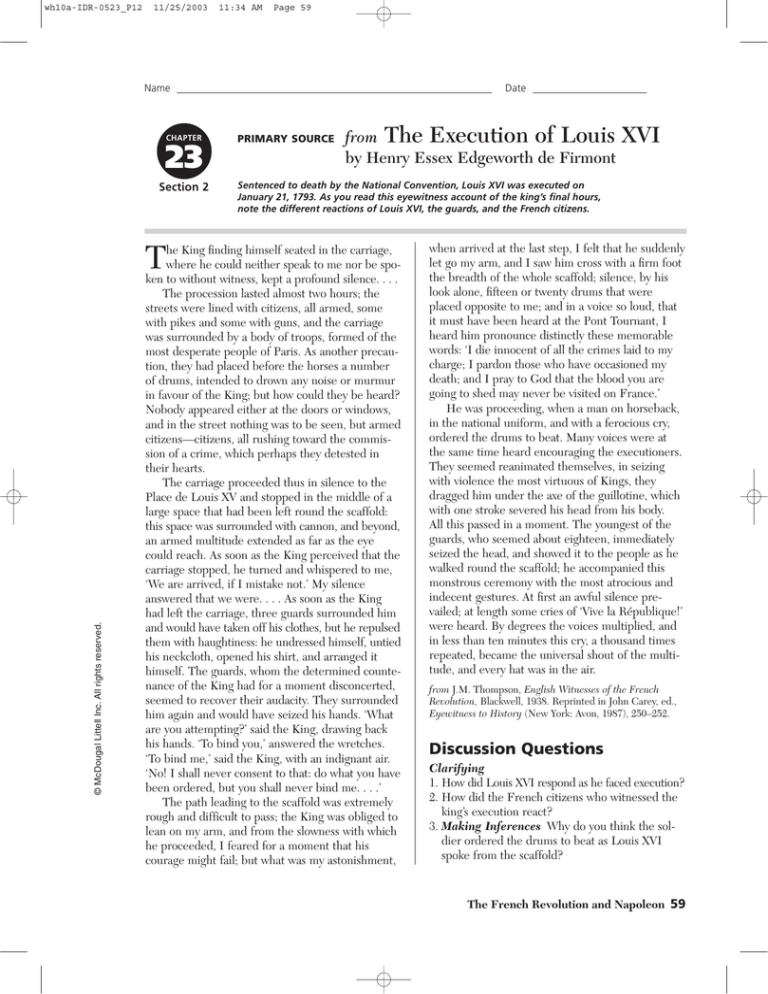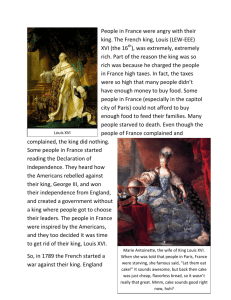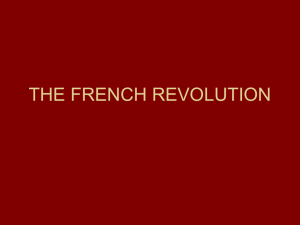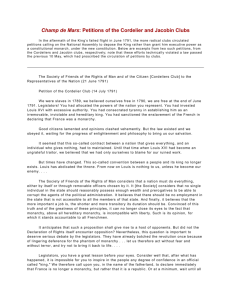
wh10a-IDR-0523_P12
11/25/2003
11:34 AM
Page 59
Name
CHAPTER
23
Section 2
© McDougal Littell Inc. All rights reserved.
T
Date
PRIMARY SOURCE
from The Execution of Louis
by Henry Essex Edgeworth de Firmont
XVI
Sentenced to death by the National Convention, Louis XVI was executed on
January 21, 1793. As you read this eyewitness account of the king’s final hours,
note the different reactions of Louis XVI, the guards, and the French citizens.
he King finding himself seated in the carriage,
where he could neither speak to me nor be spoken to without witness, kept a profound silence. . . .
The procession lasted almost two hours; the
streets were lined with citizens, all armed, some
with pikes and some with guns, and the carriage
was surrounded by a body of troops, formed of the
most desperate people of Paris. As another precaution, they had placed before the horses a number
of drums, intended to drown any noise or murmur
in favour of the King; but how could they be heard?
Nobody appeared either at the doors or windows,
and in the street nothing was to be seen, but armed
citizens—citizens, all rushing toward the commission of a crime, which perhaps they detested in
their hearts.
The carriage proceeded thus in silence to the
Place de Louis XV and stopped in the middle of a
large space that had been left round the scaffold:
this space was surrounded with cannon, and beyond,
an armed multitude extended as far as the eye
could reach. As soon as the King perceived that the
carriage stopped, he turned and whispered to me,
‘We are arrived, if I mistake not.’ My silence
answered that we were. . . . As soon as the King
had left the carriage, three guards surrounded him
and would have taken off his clothes, but he repulsed
them with haughtiness: he undressed himself, untied
his neckcloth, opened his shirt, and arranged it
himself. The guards, whom the determined countenance of the King had for a moment disconcerted,
seemed to recover their audacity. They surrounded
him again and would have seized his hands. ‘What
are you attempting?’ said the King, drawing back
his hands. ‘To bind you,’ answered the wretches.
‘To bind me,’ said the King, with an indignant air.
‘No! I shall never consent to that: do what you have
been ordered, but you shall never bind me. . . .’
The path leading to the scaffold was extremely
rough and difficult to pass; the King was obliged to
lean on my arm, and from the slowness with which
he proceeded, I feared for a moment that his
courage might fail; but what was my astonishment,
when arrived at the last step, I felt that he suddenly
let go my arm, and I saw him cross with a firm foot
the breadth of the whole scaffold; silence, by his
look alone, fifteen or twenty drums that were
placed opposite to me; and in a voice so loud, that
it must have been heard at the Pont Tournant, I
heard him pronounce distinctly these memorable
words: ‘I die innocent of all the crimes laid to my
charge; I pardon those who have occasioned my
death; and I pray to God that the blood you are
going to shed may never be visited on France.’
He was proceeding, when a man on horseback,
in the national uniform, and with a ferocious cry,
ordered the drums to beat. Many voices were at
the same time heard encouraging the executioners.
They seemed reanimated themselves, in seizing
with violence the most virtuous of Kings, they
dragged him under the axe of the guillotine, which
with one stroke severed his head from his body.
All this passed in a moment. The youngest of the
guards, who seemed about eighteen, immediately
seized the head, and showed it to the people as he
walked round the scaffold; he accompanied this
monstrous ceremony with the most atrocious and
indecent gestures. At first an awful silence prevailed; at length some cries of ‘Vive la République!’
were heard. By degrees the voices multiplied, and
in less than ten minutes this cry, a thousand times
repeated, became the universal shout of the multitude, and every hat was in the air.
from J.M. Thompson, English Witnesses of the French
Revolution, Blackwell, 1938. Reprinted in John Carey, ed.,
Eyewitness to History (New York: Avon, 1987), 250–252.
Discussion Questions
Clarifying
1. How did Louis XVI respond as he faced execution?
2. How did the French citizens who witnessed the
king’s execution react?
3. Making Inferences Why do you think the soldier ordered the drums to beat as Louis XVI
spoke from the scaffold?
The French Revolution and Napoleon 59





